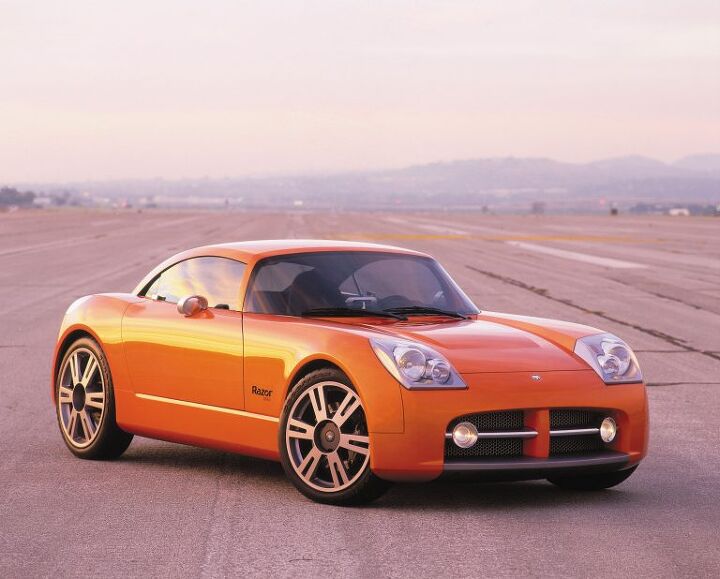A Brief History Of Chrysler/FCA/Stellantis Promises That Weren't Kept

Stellantis, formerly known as Fiat Chrysler Automobiles, spent some time last week promoting “EV Day” and talking about its EV plans.
We covered the event and the company’s plans. We’ve also noted in the past that many OEMs are talking a big game on EVs but it’s anyone’s guess if they’ll meet the timelines and goals they’ve set for themselves (speaking generally here, and not just about Stellantis).
While the future is up in the air, we do have a record of the past, and speaking about Stellantis specifically, that past has been one of unkept promises.
We can go big and talk about how the “merger of equals” never really was, or small and talk about the Dodge Razor roadster, which could’ve given the company a true competitor for the Miata.
Or we can go EV specific and talk about the company’s failure, just about a decade ago, to bring a promised EV (or three) to market.
Don’t remember this? I do. Probably cause it was a big deal at the time. Remember, there really weren’t EVs on sale yet, and the Detroit Three (still called the Big Three then) and everyone else was racing to get one on the road.
Chrysler promised an extended-range Town & Country minivan, an extended-range Wrangler, and an unnamed two-seat Dodge Sports car that was all-electric.
Only just now are we getting the first electrified Wrangler — the plug-in hybrid 4xe. Chrysler has sold a hybrid version of the Pacifica — which replaced the Town & Country — for a bit now. And that sports car never materialized, even though some folks predicted it would be on sale by the end of 2010. To be fair, Chrysler did offer hybrid models (Dodge Durango and Chrysler Aspen) back then.
“We have a social responsibility to our consumers to deliver environmentally friendly, fuel-efficient, advanced electric vehicles, and our intention is to meet that responsibility quickly and more broadly than any other automobile manufacturer,” Bob Nardelli, chairman and CEO of then-Chrysler said at the time. “The introduction of the Chrysler, Jeep and Dodge electric vehicles provides a glimpse of the very near future and demonstrates that we are serious and well along in the development of bringing electric vehicles to market.”
To be fair to Chrysler/FCA/Stellantis, a big part of the reason these vehicles didn’t make it to market was the havoc caused by the Great Recession. When Fiat took over, it disbanded ENVI, the division that was working on those vehicles, in late 2009. Fiat, of course, owned Chrysler by then thanks to the shakeups that followed Chrysler’s recession-related bankruptcy. Perhaps these vehicles would’ve made it to market had the Great Recession never occurred.
It’s not just EVs. A few years after the Razor concept came and went, Dodge had a chance to build a similar Miata-fighting roadster named the Demon, and that car, too, never was produced.
Again, in the spirit of fairness, we’ll pause to note that every car company has had hot concepts that didn’t make production for one reason or another, or has made promises it hasn’t kept. I think the Stellantis EV Day promises are sticking out more in part because of what happened with ENVI, and in part because the company has seemingly been chasing the rest of the industry when it comes to electrification over the past decade.
I’d also remind readers that past performance isn’t an indicator of future performance, so previous failures from the company don’t mean it won’t meet its goals this time around. External factors matter, too. Stellantis doesn’t seem to be on the verge of bankruptcy, the economy is recovering post-pandemic (even if it may be K-shaped), and the entire industry is more focused on electrification than it was in the late Aughts. And the tech — including support tech like charging — has advanced.
So, Stellantis may well succeed this time. But I couldn’t help but think of the past.
[Images: Stellantis]

Tim Healey grew up around the auto-parts business and has always had a love for cars — his parents joke his first word was “‘Vette”. Despite this, he wanted to pursue a career in sports writing but he ended up falling semi-accidentally into the automotive-journalism industry, first at Consumer Guide Automotive and later at Web2Carz.com. He also worked as an industry analyst at Mintel Group and freelanced for About.com, CarFax, Vehix.com, High Gear Media, Torque News, FutureCar.com, Cars.com, among others, and of course Vertical Scope sites such as AutoGuide.com, Off-Road.com, and HybridCars.com. He’s an urbanite and as such, doesn’t need a daily driver, but if he had one, it would be compact, sporty, and have a manual transmission.
More by Tim Healey
Latest Car Reviews
Read moreLatest Product Reviews
Read moreRecent Comments
- ToolGuy If these guys opened a hotel outside Cincinnati I would go there to sleep, and to dream.
- ToolGuy Michelin's price increases mean that my relationship with them as a customer is not sustainable. 🙁
- Kwik_Shift_Pro4X I wonder if Fiat would pull off old world Italian charm full of well intentioned stereotypes.
- Chelsea I actually used to work for this guy
- SaulTigh Saw my first Cybertruck last weekend. Looked like a kit car...not an even panel to be seen.



































Comments
Join the conversation
Every time I see a vehicle on the road from Chrysler/FCA/Stellantis, it's driven by someone who appears to be financially challenged.
I was expecting a dissection of the various 5 year plans put forth by FCA et al. I did not get that..